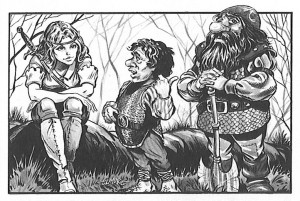Using money to restrict the use of rituals and alchemical items doesn’t work particularly well: the D&D designers have admitted this and aren’t exploring the ritual/alchemy design space much these days.
Here’s how I intend to fix the issues in my game:
1) Rituals and alchemical recipes are daily powers. You get one free use of each ritual/alchemical recipe you know. You automatically prepare the ritual, potion, or whatever during each extended rest.
During the extended rest, you can decide to prepare more than one use of the ritual or item: each extra use will cost you the item’s normal cost.
2) Rituals and alchemical recipes are given as treasures. Just as most magic items aren’t sold in magic shops, most rituals and recipes are long-lost prizes awaiting brave adventurers. Low-level parties will have access to only a few, while high-level parties, with access to lots of rituals and consumable items, will have a lot of versatility.
Rituals and alchemical recipes will be sharable among anyone who meets the requirement for using them. Knowing a recipe lets you create any version of that item of your level and lower: for instance, if a level 7 character knows the recipe for alchemist’s fire, he or she can create level 1 or level 6 alchemist’s fire.
3) There will be some common rituals and recipes. Just as characters can buy Common magic items like +1 swords, they will be able to buy well-known rituals and alchemical compounds.
Common rituals:
-All level 1 rituals
-Enchant Magic Item
-Brew Potion
-Linked Portal
-Raise Dead
Common alchemical items:
-All level 1 items
-tanglefoot bag
-alchemical silver
And for fun, here’s a new alchemical item:
Glowgas: Glowgas is stored in a vial, and thrown at enemies the same way holy water is. It has the same cost, range, and attack bonuses as holy water. It can also be applied to objects.
On a hit, the target takes no damage, but is surrounded by a swirling golden light. The target casts dim illumination within two squares, and has a -2 penalty to Stealth checks and all defenses. A creature or object in a glowgas cloud can be seen even inside a zone of darkness.
Once a turn, the target may spend a minor action to try to dissipate the gas: this allows a saving throw. Otherwise, the gas does not disperse until the next rest.
The glowgas recipe is used by dwarven drow hunters, and is only shared with those who prove themselves enemies of the drow.
 My guess: D&D Next will reintroduce “dwarf”, “elf” and “halfling” as classes, along with wizard, rogue, fighter, and cleric, so we’ll have the same stable of 7 classes that we had in Basic D&D.
My guess: D&D Next will reintroduce “dwarf”, “elf” and “halfling” as classes, along with wizard, rogue, fighter, and cleric, so we’ll have the same stable of 7 classes that we had in Basic D&D.








